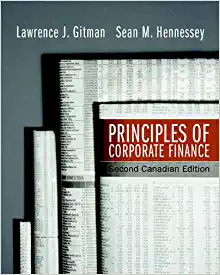Question
5 . Invested Capital, ROIC, Trade - Capital, Free Cash - flow . ABC Co. Ltd. has the following year - end accounting balance sheet.
5 . Invested Capital, ROIC, Trade - Capital, Free Cash - flow .
ABC Co. Ltd. has the following year - end accounting balance sheet.
Current Assets
$ 5 00,000
Accounts Payable
$400,000
Net Fixed Assets
$1,600,000
Short - Term Debt
500,000
Equity
1, 2 00,000
Equity on the balance sheet represents the sum of all the accounting "equity" accounts.
Expected sales for the upcoming year are $4,100,000. Costs of goods sold are 65% of sales and other operating expenses are $850,000. The interest rate on ABC's short - term debt is 10% per annum. ABC's tax - rate is 23%. Ignor e depreciation in this problem.
(a) Calculate ABC's invested capital turnover, EBITDA margin, and rate of return on invested capital ( after tax, no depreciation in this problem).
(b) ABC anticipates no net capital expenditure in the upcoming year ("net" refers to asset purchases less asset sales) and no incremental investment in trade capital. ABC expects to pay dividends equal to net income. ABC also expects to maintain the current level of its short - term debt. Find free cash flow using both the operating and the financial definitions. Does ABC have a free cash flow surplus or deficit? If ABC has a free cash flow deficit, how is it financed? If ABC has a free cash flow surplus, how is it distributed?
(c) ABC intends to expand its operations. Sales are expected to increase by $1,000,000 per annum (thereafter into the indefinite future). You do not expect that "other" operating expenses will change. You do not expect c ost of goods sold as a fraction of sales to change. W ith this increase in fut ure sales, will ABC's EBITDA margin increase or decrease? This change indicates that sales are a primary determinant of the EBITDA margin (other things equal).
The above business expansion requires an incremental investment of $400,000 in trade capital (to be maintained at this higher level indefinitely without yearly increase ) and a capital expenditure in the amount of $300,000. ABC expects to pay dividends equal to net income. ABC intends to finance these two investments with long - term debt (financin g is at the end of the year). ABC also expects to maintain the current level of its short - term debt. Find free cash flow for the upcoming year using both the operational and the financial definitions. What is the rate of return (after tax) on ABC's incr emental investment in business activity? (Hint: because the benefit of the investment is ongoing, per annum, indefinitely into the future, the investment return is the increment to the firm's after tax and after depreciation EBITDA, that is, the increment to after tax net operating income, divided by the increment to invested capital, which is the increment to trade capital plus capital expenditure). What is the impact of the new investment on the firm's FCF? Why is the fall in FCF not necessarily bad for the firm's financial asset - holders? In general terms, how who you assess, as a financial analyst, whether or not this incremental investment creates wealth of the firm's financial asset holders or not?
Step by Step Solution
There are 3 Steps involved in it
Step: 1

Get Instant Access to Expert-Tailored Solutions
See step-by-step solutions with expert insights and AI powered tools for academic success
Step: 2

Step: 3

Ace Your Homework with AI
Get the answers you need in no time with our AI-driven, step-by-step assistance
Get Started


